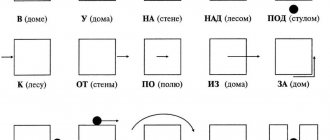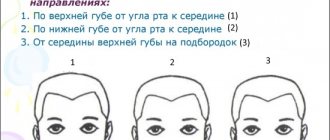Is it possible to practice making the sounds R and L without a speech therapist?
In the absence of other speech disorders, parents may well try to help their child cope with the difficult sounds R and L. In classes, it is important to adhere to the correct recommendations, consistency and regularity.
With due diligence - without overexertion and stress! - the result can be achieved without the help of a specialist. However, we note that if after one and a half to two months of regular classes, the child has not been able to “tame” complex sounds, you will still have to visit a speech therapist. The reason may be that you are not performing the necessary exercises correctly, or perhaps the child has some other speech disorders (for example, dysarthria, rhinolalia) that the parents were unable to identify on their own.
Articulation exercises
- “Delicious jam!” : We move a wide tongue over the lips, as if we are licking something tasty, while the lower lip does not help the tongue. We do this for one minute.
- "Broad smile" . Smile from ear to ear for 10 seconds, with your lips closed. Recommended repetition 7-8 times.
- "Breeze". During this exercise, keep your mouth slightly open, bite your tongue with your lips and blow with all your might (2-3 minutes per session).
- Compete to see who has the longest tongue, and try to reach your nose and chin.
- "Tube". A funny exercise for training your tongue when you roll it into a tube.
- "Horse". Clack along with your baby like a horse, gradually increasing the pace. Make sure that the lower jaw does not move.
- “Hammock”: Here the tip of the tongue rests on the upper front incisors so that it is shaped like a sagging hammock. The longer the tongue is held in this position, the better.
- “Mushroom” is the most effective exercise for stretching the frenulum. The baby's tongue should fixate (“stick”) on the upper palate for 20–30 seconds.
- “Swing”: with a wide smile, alternately rest the tip of your tongue on the upper and lower incisors.
- Sound “y”: ask the child to pronounce this sound long and drawn out, so that the tip of the tongue is deeply hidden in the mouth, and the back touches the sky.
It will take 3-4 weeks to teach this difficult sound, as well as consolidate it, do not rush and do not stop at the achieved result.
Breathing exercises and a fun game with soap bubbles help a lot in pronouncing sounds. It is also useful to blow on dandelions, candles, and feathers with your toddler.
Speech development is facilitated by creative activities such as drawing, mosaics, modeling, sewing, i.e., everything related to fine motor skills.
Don’t be upset if your child can’t speak the hard sound [L] at first. Soft [L´], for example, it appears in children due to excessive tension in the labial muscles, which quickly passes.
How to learn to speak R - sound production
- We develop articulation. By the way, this “secret” will be useful for any problems with sound pronunciation. Exercises will help develop the articulatory apparatus. Remember the cartoon about a baby elephant and a boa constrictor? They had exercises for the tail, and you will have exercises for the tongue! It’s not difficult to find the exercises you need online. The simplest ones include clicking like a horse, sticking out your tongue, curling it into a tube, and so on. This is the case when grimacing is not only possible, but also necessary!
- Perhaps the reason is a short frenulum of the tongue. The operation to trim it is simple and the wound heals in a few days. If you are not ready, try stretching it. Invite your baby to reach the tip of his nose with his tongue. Does not work? We stretch every day. Gradually the frenulum will stretch and the sound P will become more accessible.
- Let's start getting the sound. The child puts his finger under his tongue, which he begins to move from side to side, gradually beginning to “growl.”
- Another option for producing the sound R. Let the child open his mouth and pronounce the sound “z-z-z”. At this time, with the tip of your finger (you can put a baby pacifier on it or use a special speech therapy probe), try to move the frenulum of the tongue back and forth, creating vibration. If the exercise is done correctly, you will hear a wonderful R sound.
- Another way. Ask your child to cup his tongue and, pressing the tip of his tongue against the roof of his mouth, forcefully pronounce the sound “ddd.” Let the child tug on the frenulum with his finger, feeling the vibration. This way you will also get the R sound.
Causes of speech defects in children
Most sounds, including “l,” should be formed in a child by the age of 4-4.5 years. And if this does not happen, then you should think about the reasons. For example, he may not be able to pronounce all the sounds because someone in the family has a speech impediment, and the baby simply copies him. This often happens in bilingual families, when it is difficult for children to figure out where, what and how to pronounce. The cause may also be a violation of the development of speech hearing (incorrect hearing of sounds), as well as pathologies of speech breathing and hearing loss. The structure of the articular apparatus (tongue, lips, teeth) is of no small importance: for example, a shortened frenulum makes it difficult to pronounce the sound “l” correctly, because the tongue simply does not reach the upper teeth.
Anatomical features can only be determined by a specialist, so do not try to draw your own conclusions. And don’t be alarmed if the doctor sees a shortened frenulum - today in most cases they prefer to stretch it with the help of special exercises rather than cut it.
Variants of incorrect pronunciation of the sound “l”
- The sound “l” is absent - the child simply skips this letter (shovel - opata);
- Replacing “l” with “y” (horse - horse);
- Replacing “l” with “th” (spoon - yoshka, milk - moyoko);
- Sometimes a child correctly pronounces a hard “l” and distorts a soft one, and vice versa.
If your speech therapist has not identified any serious deviations, then you can safely begin exercises on making the sound “l” at home. First of all, we need to determine how we produce this sound (interestingly, the position of the tongue may differ slightly among different people with normal diction).
Correct position of articular organs
- The tip of the tongue rests on the base of the upper teeth (it can also be on the upper alveoli or rests on the gap between the upper and lower teeth).
- The air passes along the sides of the tongue (the air flow needs to be quite strong).
- The lateral edges of the tongue do not rest against the upper or lower lateral teeth.
Usually the sound “l” is placed without much difficulty (sometimes a few lessons are enough). We will give tips on how to help your child learn to pronounce the letter “l” at home. Combine exercises with articulation gymnastics, which will help improve the mobility of the lips, tongue, and laryngeal muscles. Children usually like these activities because they can make faces to their heart's content.
Exercises for training "l"
- Smile. You need to smile from ear to ear, without opening your lips, and stay in this position for up to ten seconds (7-8 times a day).
- Breeze. Open your mouth a little, bite your tongue a little with your lips and blow hard (up to three minutes a day).
- Delicious jam. Circular movements of the tongue over the lips, as if we are licking something tasty (1 minute).
- Clattering. Ask your baby to click like a horse, gradually speeding up. In this case, the lower jaw should remain motionless. Then do the same exercise, only more quietly, as if the horse is sneaking.
- Long tongue. Invite your baby to stick out his tongue as far as possible and try to reach either his chin or his nose.
- Tube. Roll your tongue into a tube several times a day - it’s both useful and fun.
- The sound is "y". Ask to say “y-y-y”, but so that the tip of the tongue is in the back of the mouth, and its back is raised to the palate.
- Breath. Do breathing exercises more often: blow soap bubbles, blow on dandelions and lighted candles, instill in your child an interest in singing.
- Fine motor skills. Do modeling, sewing, drawing, applique more often - stimulation of the nerve endings on the hands will help in the development of speech and intellectual development in general.
How to organize classes correctly
First of all, we must remember that all exercises should be done in the form of a game. Think in advance about how you will work with your baby, because just one wrong move or word can put pressure on the child, and he will refuse the procedure. Please note that the child cannot always understand the deep meaning and significance of speech therapy exercises for his future, so the atmosphere of the game is very important. Start small, 1-2 exercises a day, so as not to overtire your baby. Conduct classes so that the child can clearly see his and your face, that is, in front of a mirror, with normal lighting, and preferably in a sitting position. The main thing is to remember to praise your child as often as possible.
How to learn to speak the sound L
- Preparatory exercises - clopping like a horse with a gradual change in volume and speed of sound. Watch your lower jaw - it should not move!
- “The wind is blowing” - the child should press the tip of the tongue between the teeth so that there is space on the sides. You need to blow air on different sides of the tongue.
- Let's try to hear L. With the tongue clamped between the teeth, ask the child to say “yyy” or “uuu”. The desired sound will appear by itself. Make sure later that the “correct” L is pronounced with the tongue retracted.
Preparing the speech apparatus to pronounce the sound L
- To perform an exercise called “Smile” you need to do the following: smile so that your lips stretch, and then return to their original state.
- The “tube” can be made using two methods. The first is to clench your teeth, pull your lips forward and transform them into a square. Second - imitate the pronunciation of the sound U (only without voice).
- “Needle” : smile and stick your sharp tongue out of your mouth.
- “Let's punish the naughty tongue” : Place a wide tongue on the lower lip. You can make a small hollow. It is important that the tongue is not too tense.
- “Turkey” : open your mouth slightly, place your tongue on your upper lip, and then make stroking movements with it from top to bottom. You can add the sound combination “bl-bl-bl”.
- “Ride a horse” : smile, lift your tongue up to the alveoli and “suck.” Then click it, imitating the “clatter of hooves.”
- “Let's go on a swing” : smile. First, lower the sharp tip of your tongue by the lower teeth, and then lift it by the upper ones.
Automation of sounds R and L
It is not enough to learn to pronounce a sound separately from words, you also need to consolidate it in speech. As speech therapists say, automate it. The child must pronounce all sounds correctly, without thinking about where to place the tongue and what to do.
The following exercises are great for strengthening the pronunciation of the desired sound:
- Clear repetition of syllables with the “necessary” letter - dra-dru-dra, le-la-lo-lu-li, etc.
- Search for words starting with the required letter. Lay out pictures from children's lotto or simply open a book with bright illustrations. Ask your child to find and name objects containing the letter P or L. Watch the pronunciation.
- A little later, tongue twisters and tongue twisters will be perfect. You yourself know about Greku, who rode across the river and the grass on which firewood lay. Let us suggest a few more: “the quail hid the quails from the guys”, “the ships maneuvered and maneuvered but did not catch them”, “there are pins at the Christmas tree”, “have you washed the raspberries? They washed it, but they didn’t wash it.”
There are a lot of options for automating sounds. The main thing is to practice systematically and make sure that the child pronounces the sound correctly and clearly.
Learning to pronounce the sound L
Very often we can encounter a violation of the pronunciation of the sound L, which is called lambdacism. So, instead of the word “shovel”, we can hear different sound combinations, for example, “ropata”, “uvapata”, etc. If a three-year-old child says this, it may even touch someone. But when an adult continues to say this, it most likely causes ridicule from others.
In order not to lead to such a deplorable state, you need to contact a speech therapist in a timely manner. And this should be done as early as possible.
There are cases when speech therapists believe that it is possible to correct the incorrect pronunciation of the sound L in older preschool age or even in primary school age. Believe me, these experts are wrong. After all, the child’s mastery of sound-letter analysis of words, writing and reading depends on how well a child speaks. And in general his formation as a successful person.
If you do not want to wait for a speech therapist to provide qualified assistance to your child, you can try to do it yourself.
What should be the position of the organs of articulation for the correct pronunciation of the sound L
- the position of the lips changes and depends on the vowel sounds following the sound L;
- the upper and lower teeth should be a short distance from each other;
- The fairly tense tip of the tongue should rest against the upper teeth or gums;
- the edges of the tongue (namely the lateral ones) should not be adjacent to the upper molars in order to leave passages for exhaled air;
- the root of the tongue is raised;
- the soft palate should be raised so as to close the passage into the nasal cavity;
- vocal cords vibrate.
The most common mistakes when pronouncing the sound L
- the tongue is pulled back into the mouth, the sound Y is heard, for example, “yoozhka” instead of “spoon”;
- incorrect position of the lips, the sound combination “uva” is heard, for example, “pashuva” instead of “went”.
- replacing the sound L with the sound R, for example, “redheads” instead of “skis”;
- forced exhalation, resulting in a sound similar to the F sound (with the participation of the cheeks) or the N sound (air flows through the nose).
Preparing the speech apparatus to pronounce the sound L
To perform the “Smile” exercise, you need to do the following: stretch your lips into a smile, and then return them to their original relaxed state.
The “Pipe” exercise can be performed in two ways. The first method is to imitate the pronunciation of the sound U (without voice). The second way is to clench your teeth, pull your lips forward and transform them into a square.
Exercise "Needle". Stretch your lips in a smile, stick your sharp tongue out of your mouth.
Exercise “Punish the naughty tongue.” Place a wide tongue on the lower lip. You can form a small hollow. The main thing is not to strain your tongue too much.
Exercise "Let's ride on a swing." Stretch your lips into a smile. First, lower the sharp tip of the tongue behind the lower teeth, and then lift it up by the upper teeth.
Exercise “Ride a horse.” Stretch your lips in a smile, lift your tongue up to the alveoli and “suck.” Then click it, imitating the “clatter of hooves.”
Exercise "Turkey". Open your mouth slightly. Place your tongue on the upper lip, and then make stroking movements with it from top to bottom. You can add the sound combinations “bl-bl-bl”.
Several ways to make the sound L
First way. Invite your child to pronounce the sound Y. Then ask him to repeat after you simple words that contain the syllable LY, for example, skis, bast, etc. As soon as the baby manages to pronounce the sound L in the interdental position, show him the correct position - the tip of the tongue should be raised up and rest against the teeth or gums.
Second way. Invite your child to open his mouth wide. It is best if both the lower and upper teeth are visible. After this, ask the baby to stick his wide tongue out between his teeth, pronounce the sound A and at this moment lightly press it with his teeth. The response should be a combination of the sounds L and A. When the child can confidently pronounce the sound L in this position, the tongue should be moved to the correct position.
General recommendations for independent speech therapy sessions
- Classes should not overload the child. The length of one “lesson” should not be more than 45 minutes.
- Be sure to alternate types of tasks so that your child does not get tired.
- Support and praise your child for every positive change. You should not swear or get angry if something is done incorrectly. Perhaps while the articulatory apparatus
- is not ready to pronounce such a complex sound, or your son or daughter does not fully understand what he needs to do.
- Use a mirror when practicing. Looking into it, it is more convenient to control articulation.
- Use all kinds of games and entertainment to keep your child interested and prevent him from becoming overtired.
- Lessons do not have to be done at home at the table. Communicate more - on a walk, during everyday activities. Ask questions, encouraging them to pronounce the correct letters.
- Don’t quit classes “halfway”! If it seems to you that the sound has already been achieved, you definitely need to introduce it into speech, bring the pronunciation to automatism. Otherwise, all your and your children’s efforts will be in vain.
- Be friends with your child. Support and encourage each other. By dealing with such a problem, you can convey to him that he can overcome many problems in his life. With your support or on your own.
Date of publication: 07/09/2016. Last modified: 05/09/2018.
The feasibility of speech therapy classes
Some parents do not think about how to teach their child to say the letter L. They do not consider the defect to be something serious, but in adult life it will become the basis of complexes and worries.
Important! It is better to correct speech disorders in preschool age, then the process will take a little time.
What to do if a 3-year-old child speaks only the first syllables of words
If parents do not know how to correctly teach their child to pronounce the letters L and R, then they should contact a specialist. A speech therapist will be able to correct this problem and develop the desired pronunciation.
How many lessons does it take to produce sound [l]
It is impossible to say with certainty how many lessons will be required to eliminate the defect. Sometimes sound production takes one session, in other situations it will take more than 30-40 meetings.
It all depends on the characteristics of the child, his motivation and the interest of the parents. Learning to pronounce the sound [l] is not so easy, since a preschooler gets used to a certain stereotype. Due to their age, it is still difficult for children to perceive learning activities.
How does an individual sound production lesson work [l]
The speech therapist performs sound production only after the student performs articulatory gymnastics well. The complex is performed strictly in front of a mirror. Afterwards they do breathing exercises and perform speech hearing tasks.
How does an individual lesson on sound automation work [l]
The speech therapist conducts individual lessons on automating the sound [l] only after calling an isolated pronunciation. At such lessons, the specialist develops the lexical and grammatical structure of speech, phonetic and phonemic hearing.
To do this, use different games and simulators. Modern speech therapists use computer games. Parents are required to participate in the process and carry out the specialist’s tasks at home.
Important! The duration of the lesson for preschool age is approximately 25 minutes. Physical minutes are required to switch activities.











